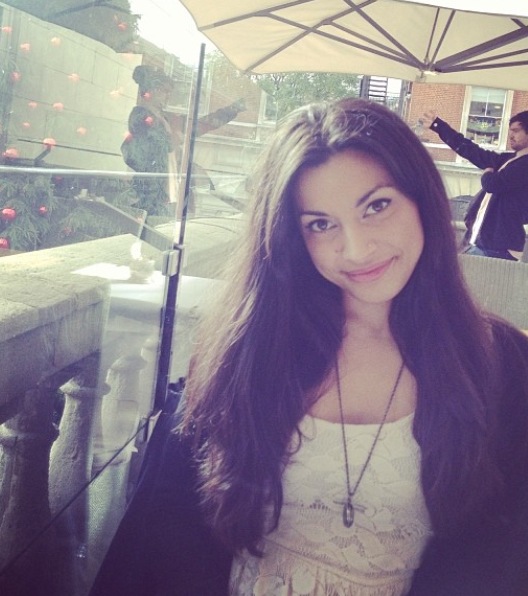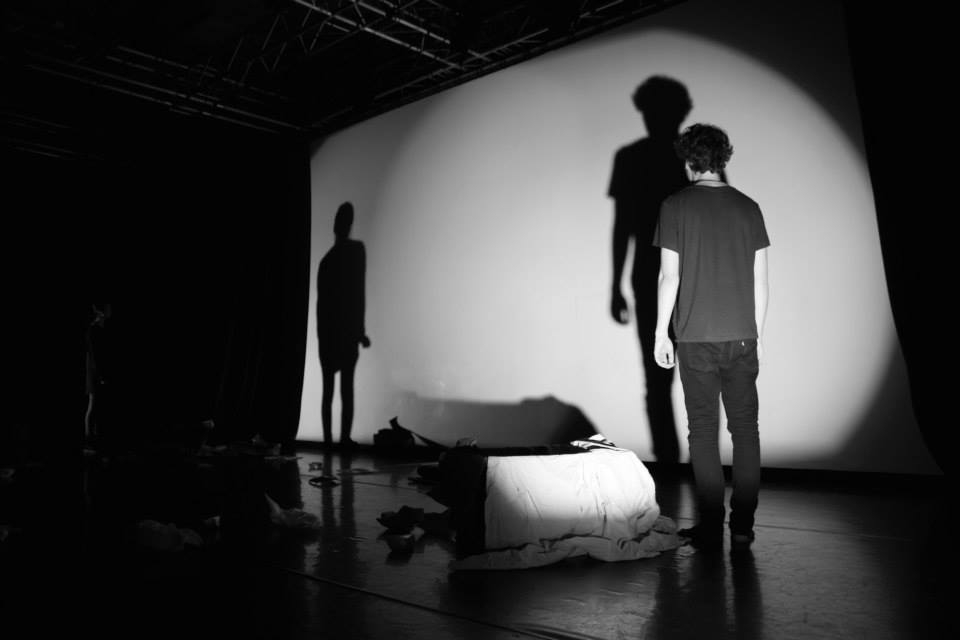Tango at the End of Winter

Tango at the End of Winter by Kunio Shimizu
Directed by Annabelle Sami
Richmix London
Cast: Liam Anderson, Bruno Cooke, Anissa Eckoff, Paulina Musayev, Ari Rice, Annabelle Sami, Peter Walker. (Sarah Suzuki, Jasmine Gould-Wilson)
Friday 9 January 2015
Review by Susan Meehan
A seemingly bright young actor on the cusp; squaring up to middle-age dementia, loss and angst he decides to abandon his career. He is reluctant to grow old and is still firmly set in his belief that the beautiful die young, stubbornly withdrawing into memories of his youth.
Sound contradictory? That is what you get when a fresh-faced university drama group bravely take on an unusual challenging play, with mature roles. Kunio Shimizu’s 1984 masterpiece, Tango at the End of Winter touches on loss and decay but with a light touch, deft accessible dialogue and ample humour.
The play’s setting is a decrepit family-run cinema in a small northern town on the Sea of Japan coast, soon to be turned into a supermarket. It is here that we encounter Sei, a middle-aged actor, who like the cinema, is all washed up.
Sei’s mental deterioration is palpable. He has to rack his brain before recognising his brother, Shigeo, and thinks his wife, Gin, is his sister, who in fact died years earlier.
The play speedily charts Sei’s demise over three years. Gin, his wife, initially optimistic, begins to lose hope that he will ever get better.
Beautiful Mizuo, an actress from Tokyo, who performed in plays with Sei, has been summoned to pay him a visit. He appears not to recognise her and to think she has come to see a film at the cinema.
Mizuo eventually reveals to him that she is an actress and that they have worked together. When they first met, Sei’s advice to her was that as an actress she should not to live too long and that she ought to have an all-consuming love affair. Does Sei really not recognise her? Can he be feigning?
Three years ago she did have a love affair with a fellow actor, but is certain that this had been contrived by the actor’s wife in order to restore his brilliance and sparkle– it was all an elaborate act that lasted three months. Mizuo is enraged just by remembering this duplicity.
Having been summoned to the cinema Mizuo once again feels she is being used to make Sei better.
The second half of the play, staged by the Queen Mary University Theatre Company at the Rich Mix, unfolded with greater theatricality and at a faster pace than the first, cantering swiftly to its denouement. Sei continues to be delusional, hears voices and remembers a peacock that he had stolen as a child.
Ironically he considers Mizuo to be batty, but in her ‘madness’ he perceives a strange sparkle. It is apparent that this sparkle attracts him and an intensity between the two emerges, skilfully and credibly played by the two actors, Liam Anderson and Paulina Musayev.
There is also more humour in the second half. Ren, Mizuo’s husband, a nervous wreck threatened and tormented by the evolving affinity between Mizuo and Sei, obsessively gorges on food. It was funny to watch this spectacularly hammed up by Peter Walker.
By the close of the play, Sei is totally deranged, and the ending is bothbold and surprising. In the aftermath, Gin surveys the cinema, leaves and says it is beautiful and sad.
What is she referring to? The cinema in particular, youth, or life in general?
The play is replete with the blurring of illusion and reality as all characters, not just Sei, struggle with identity issues. Shigeo has to deal with the unexpected responsibility of having had to take over the family cinema as Sei, the eldest brother, had decided to become an actor and their other elder siblings died. Mizuo has to deal with Sei’s unrecognition, Gin is confused by Sei treating her as his sister – is this a convenient tactic of his – and Ren wonders how much Mizuo really loves him. Even the cinema has to face the indignity of extinction in favour of a more commercially viable supermarket.
The theatre critic John K Gillespie talks about Kunio Shimizu being a child of the American Occupation (1945-1952) and grappling with the change in Japan’s identity after the war in his book Alternative Japanese Drama, Ten Plays, (edited by Robert T Rolf and John K Gillespie, University of Hawaii Press, 1992, p 116). This theme of identity is strongly portrayed in Annabelle Sami’s production.
The Queen Mary University Theatre Company, directed on this occasion by Annabelle Sami did an excellent job of staging the play and of giving it a Japanese flavour by using words in Japanese throughout such as ‘konnichiwa’, ‘yamete’, ‘obasan’ and ‘otoko’. Sami knew she wasn’t going to get an all-Japanese cast but with the mix of accents and nationalities was able to create a sense of ‘otherness’.
All credit goes to Liam Anderson as Sei Kiyomura who played this most challenging part with great versatility and nuance. Annabelle Sami as Gin Kiyomura also put in a striking performance as a wife and actress doing all she can to bring her husband back to normality. She also did a fine act of directing. Paulina Musayev was perfectly cast as the beautiful young starlet, Mizuo. The use of Japanese mannerisms and the occasional Japanese words as well as Sami’s choice of a range of international actors also gave the play a non-British, almost Japanese quality – a tremendous achievement.
Most striking was that such young actors could play roles designed for much older thespians with considerable aplomb. Lines were fluffed on a couple of occasions and there were a couple of wardrobe malfunctions but nothing that could not have happened to any cast on its first/only performance at the Rich Mix. I look forward to their next performance.
The playwright and director Kunio Shimizu was born in Niigata in 1936 and studied drama at Waseda University. He has won a number of Japanese drama awards and has collaborated with fellow director, Yukio Ninagawa. Tango at the End of Winter was first performed in 1984. Its first performance in London was in 1991, directed by Yukio Ninagawa and featuring Alan Rickman as the main lead, Sei Kiyomura.
Below follows an interview with Annabelle Sami conducted on 12 January 2015:
1 Who chose to put on this play and why?
I chose to put on the play. I suppose the main reason for choosing Tango is that I love Japan and I love theatre, but realised that I had never seen a Japanese play performed in the UK. The theatre company were holding a festival to put on contemporary plays so I thought it a good opportunity to look up some contemporary Japanese theatre. There were two Shimizu plays that I came across English scripts for but this play really appealed to me with its exciting narrative and interesting characters. I also liked the fact that the women characters in the play were very complex and had interesting storylines.
2 Has the Queen Mary Theatre Company put on other Japanese plays in the past?
Last term QMTC staged an adaption of Akira Kurosawa’s ‘Rashomon’. The stage adaptation of classic Japanese films is something we will continue to explore in the future.
3 Other than adaptations of classic Japanese films, do you have plans to stage other types Japanese plays?
Personally, I very much want to stage more Japanese plays, the difficulty of course is that not many are translated into English. I am currently learning Japanese but am nowhere near able enough to translate them myself! But I think that plays are a brilliant way to show audiences who may have little experience of Japanese culture, insights (although dramatized) into Japanese life.
4 Will you perform this play again? It was on for just one day at Rich Mix but has it had a longer run elsewhere?
We performed this play once in November 2014 at Queen Mary University, and then were asked to perform again at Rich Mix. Although we would love to perform it again, I am a student and therefore have very limited funds to try and put it on elsewhere! I’m also very keen to discover new Japanese plays and put them on.
5 Who helped with the Japanese pronunciation of words such as ‘konnichiwa’, ‘obasan’, ‘otoko’, ‘yamete’ which were used in the play and with how to bow?
I have long been interested in Japan, hosted Japanese students and got to go on an exchange to Hiroshima in 2010 so I am aware of certain pronunciations and small phrases. As I said I’m also learning Japanese but still very much a beginner!
We also had great help from Anissa, who played Hanna, as she grew up in Japan and so we had mini workshops working on the etiquette of bowing and language.
I thought as we were already performing the play in English, it was important to try and retain some of the ‘Japanese’ in it, and hopefully show respect to the culture through not entirely westernising the play.
6 What do you feel is distinctively Japanese about this play?
Aside from the obvious inclusions of Japanese names and allusions to the Sea of Japan and apples from Aomori, what I found distinctively Japanese about the play was the writing. Although of course it has been translated and adapted I found much of the language very light and beautiful, something that I recognise in other Japanese writers that I have read. Particularly the image of snow and blossom reminded me a lot of Snow Country by Yasunari Kawabata. I know this is just my personal interpretation, but I do find this style of writing distinctively Japanese. It’s sort of beautifully descriptive but in an economical way – I think Murakami has this quality too.
7 What do you think the play is trying to say?
I think the play is trying to tell us many things, but the main theme I focused on was the real and the represented. This is why I liked the idea of shadows, because I think they fall somewhere in between, caused by something real but only showing the representation of it. There is so much blurring between reality and fiction in the play that sometimes it is difficult to know whether characters are speaking or quoting. They all seem to be ‘pretending’ in some way – Sei constantly flits between roles from his past, Gin pretends to be a sister and a wife (while orchestrating fake affairs), Mizuo pretends to love Ren – and of course this is all happening under the incredibly metatheatrical truth that we are all acting in a play. I think Shimizu is trying to tell us that characters and acting are not something restricted to the cinema, or the theatre, but something we all play in real life.
8 Can you tell me a little about your company? Are you all students? How long do actors tend to stay with Queen Mary Theatre Company?
Queen Mary Theatre Company changes its committee every year, but is always run by students. They hold festivals throughout the term where students can pitch plays to put on which are then voted in or not. I pitched Tango and as it was chosen to be in the festival I could then audition actors etc. who must all be part of the university and society. How long actors stay with the company depends on if they continue to audition for plays and if you stay involved with pitching ideas and such. But in general it is very low pressure and good if you are like me and enjoy directing but also performing!
9 Have you directed before?
I have always been involved in performance and I study drama but I have never directed before – this is my first show! I really enjoyed directing and will definitely continue. Unfortunately one of my actors had to fly to America and another Hong Kong so I ended up last minute taking the role of Gin and the other role was filled by Anissa.
10 Name one of your favourite actors, play, and playwright?
I don’t know if I could name a favourite actor or play, but a performance that I’ll never forget is Apphia Campbell’s Black is the Color of My Voice which she wrote and performed in. In terms of playwrights I of course really like Kunio Shimizu, and also more classic playwrights like Arthur Miller and Tennessee Williams.
11 What will you do next?
I am hoping to create a piece that uses Kabuki theatre in form and history as its inspiration and set it in London. Aside from this I am going to continue seeking out Japanese writing to showcase in London as I believe it’s a wonderful way to form cultural links between our countries.


